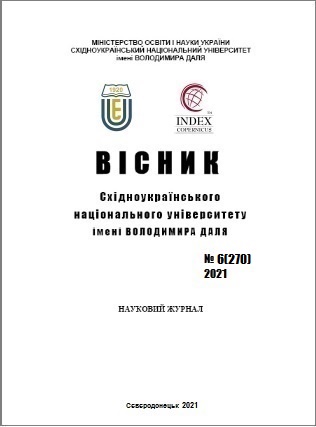Теоретико-прикладні аспекти застосування системи центрів відповідальності в управлінні процесом реалізації операційної діяльності господарчого суб’єкта
DOI:
https://doi.org/10.33216/1998-7927-2021-270-6-106-114Ключові слова:
операційна діяльність, ключові показники операційної діяльності, цикл процесів операційної діяльності, види операційної діяльності, центр відповідальності, класифікаційні ознаки центрів відповідальностіАнотація
У статті, на основі наявних теоретичних досліджень й застосовуваних практик, уточнений й поглиблений поняттєвий апарат сфери застосування центрів відповідальності в управлінні процесом реалізації операційної діяльності, зокрема розкрито зміст понять «операційна діяльність» та «центр відповідальності»;уточнений перелік ключових показників у розрізі циклів реалізації операційної діяльності господарчого суб’єкта, контроль над якимивстановлений з боку керівників центрів; розширена класифікація центрів відповідальності за управлінськими й операційними критеріями; сформовані оновлені характеристики центрів відповідальності операційної діяльності залежно від ключових показників за відповідними циклами її реалізації й уточненими класифікаційними ознаками самих центрів.
Посилання
1. Белінський П.І. Менеджмент виробництва та операцій. К.: ЦУЛ, 2006. 684 с.
2. Василенко В. О. Ткаченко Т. І. Виробничий (операційний) менеджмент: навчальний посібник / За заг. ред В.О. Василенко. К.: ЦУЛ, 2003. 532
3. Тлумачний словник бухгалтерських та суміжних економічних термінів. Харків. нац. ун-т міськ. госп-ва ім. О. М. Бекетова; уклад. А. П. Косяк. Харків: ХНУМГ ім. О. М. Бекетова, 2020. 71 с.
4. Капінос Г. І. БабійГ. І. Операційний менеджмент: навч. посіб. К.: Центр учбової літератури, 2013. 352 с.
5. Идельманов С. В., Идельманов А. С., Лобов С. В. Операционный менеджмент. М.: ИНФРА. М, 2005. 337 с.
6. Бочаров В. В. Коммерческоебюджетирование. – СПб.: Питер, 2003. 368 с.
7. Вербовецька С. Г. Формування центрів відповідальності в системі бюджетування підприємства. Вісник Хмельницького національного університету, 2011. С. 344–356.
8. Друри К. Введение в управленческий и производственныйучет. М.: Аудит, ЮНИТИ, 2006. 560 с.
9. Білоусова І. Роль управлінського обліку в підвищенні ефективності виробництва. Бухгалтерський облік і аудит. № 4,5, 2005. С. 44–47, 31–34.
10. Вахрушина М. А. Бухгалтерскийуправленческийучет: учеб. для студентоввузов, обучающихся по экон. специальностях. М.: Омега-Л, 2007. 570 с.
11. Лень В. С. Управлінський облік: навч. посіб.К.: Знання-Прес, 2006. 317 с.
12. Голов С. Ф. Управлінський облік: підручник. К.: Лібра, 2003. 704 с.
13. Бухгалтерський управлінський облік: підручник для студентів спеціальності «Облік і аудит» вищих навчальних закладів / За ред. проф. Ф.Ф. Бутинця. Житомир: ПП «Рута», 2005. 480 с.
14. Партин Г.О. Управління витратами підприємства: концептуальні засади, методи та інструментарій: Монографія. К.: УБС НБУ, 2008. 219 с.
15. Миронова Ю.Ю. Облік витрат за «центрами відповідальності» та «центрами витрат» на підприємстві. Науковий вісник Ужгородського університету. Серія: Економіка. Ужгород: УжНУ, 2010. № 29. Ч. 1. C. 174–178.
16. Ясишена В. Сутність грошових потоків підприємств та їх класифікація. Вісник ТНЕУ. Економічний аналіз. 2008. Вип. 2(18). С. 321–324.
17. Энтони А. Аткинсон, Раджив Д. Банкер, Роберт С. Каплан, Марк С. ЯнгУправленческийучет / пер. с англ. 3-е изд. М.: Издательскийдом “Вильямс”, 2005. 878 с.
18. Моргулець О. Б. Менеджмент у сфері послуг:навч. посіб. К.: Центр учбової літератури, 2012. 384 с.
19. Кравцова О. А., Христенко Л. М. Значення центрів відповідальності для функціонування операційної системи підприємства. Технологія-2021: XXIV матеріали міжнар. Наук.-техн. конф., 16 квіт. 2021 р., м. Сєвєродонецьк / укл.: Тарасов В. Ю. Сєвєродонецьк: СНУ ім. В. Даля. С. 237–239.
20. Матвієнко А.В., Христенко Л. М. Напрями удосконалення системи операційного менеджменту на підприємстві. Матеріали XХІІІ Міжнародної науково-технічної конференції «Технологія-2020», 24 -25 квітня 2020 р. Сєвєродонецьк: СНУ ім. В. Даля, 2020. С. 211–213.
21. Давидович І. Є. Контролінг Навчальний посібник. К.: Центр учбової літератури,2008. 552 с.
22. Білик М. Д., Павловська О. В., Притуляк Н. М., Невмержицька Н. Ю. Фінансовий аналіз: навч. посіб. К.: КНЕУ, 2005. 592 с.
23. Ходзицька В. В., Івченко Л. В. Стратегічний управлінський облік в системі комплексного менеджменту суб'єктів господарювання. Облік і фінанси. 2014. № 1. С. 50–55.
24. Чуприна Л. В. Управлінський облік у сучасному менеджменті підприємства. Вісник Національного технічного університету «ХПІ». Сер.: Технічний прогрес та ефективність виробництва. 2014. № 34. С. 154–158.

